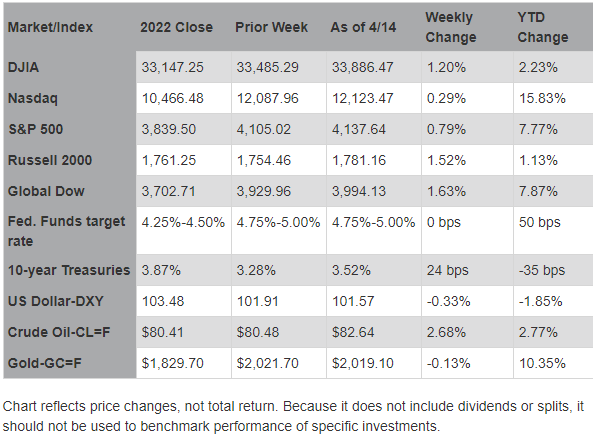Market Week: April 17, 2023
Presented by William Prentice, AWMA®, CFP®, CIMA®
Key Dates/Data Releases
4/18: Housing starts
4/20: Existing home sales
THE MARKETS (as of market close April 14, 2023)
Investors spent much of last week contemplating the impact of the latest inflation data and the first batch of first-quarter bank earnings. The process of disinflation continued, and retail sales softened in March, which are developments that could influence interest-rate decisions to be made by the Federal Reserve in the coming months. The stock market closed out the week with gains across the board, despite a couple of rough patches. The Global Dow increased 1.6%, followed by the Russell 2000 (1.5%), the Dow (1.2%), the S&P 500 (0.8%), and the Nasdaq (0.3%). Ten-year Treasury yields moved up 24 basis points. The dollar weakened against a basket of currencies, oil prices dipped, and gold prices were little changed.
Last week began with stocks moving generally higher. The Russell 2000 (1.0%), the Dow (0.3%), and the S&P 500 (0.1%) gained ground, while the Nasdaq was flat. The Global Dow slipped 0.2% lower. The yield on 10-year Treasuries climbed 12.7 basis points to 3.41%. Crude oil dipped about 1.0% to $79.85 per barrel. The dollar gained nearly 1.0%, while gold prices fell by 1.0%. Investors remained cautious, possibly anticipating another interest-rate hike from the Federal Reserve, particularly following the previous week's solid jobs report.
Stocks notched another low-volume trading session last Tuesday. Tech shares lagged for the second consecutive day. Large caps fared better, with the Dow up 0.3%. The S&P 500 ended the day where it began, while the small caps of the Russell 2000 rose 0.8%. The Global Dow gained 0.7%. Ten-year Treasury yields inched up 1.9 basis points to 3.43%. Crude oil prices advanced to $81.47 per barrel. The dollar slid lower, while gold prices gained to remain above $2,000.00 per ounce for the sixth straight session.
After trading higher for much of the day, stocks weren't able to maintain that momentum, ultimately closing lower last Wednesday. A slowdown in the latest Consumer Price Index wasn't enough to calm cautious investors. The minutes of the last meeting of the Federal Open Market Committee, released last Wednesday, revealed that Fed officials agreed that another rate hike was needed, despite concerns that raising interest rates may cause more financial stress, particularly in light of the recent failure of two regional banks. By the close of trading, only the Global Dow posted a gain (0.3%). Tech shares declined for the third straight session, dragging the Nasdaq down 0.9%. The Russell 2000 fell 0.7%, the S&P 500 slid 0.4%, and the Dow dipped 0.1%. The yield on 10-year Treasuries slipped marginally, closing at 3.42%. Crude oil prices rose 2.0% to $83.24 per barrel. Gold prices gained nearly 0.5%, while the dollar dipped 0.6%.
Wall Street bounced back last Thursday after the producer price index provided more evidence that inflation is continuing to ease. The Nasdaq led the increase, climbing 2.0%, followed by the Russell 2000 and the S&P 500, each rising 1.3%. The Dow (1.1%) and the Global Dow (0.8%) also closed higher. Communication services and consumer discretionary led the market sectors, both moving up 2.3%. Ten-year Treasury yields ticked up to 3.45%. The dollar slipped and gold prices advanced 1.5%. Crude oil prices dropped 1.1% to $82.32 per barrel.
On Friday, all of the stock indexes listed here ended the day in the red. The Russell 2000 lost 0.9%, followed by the Dow and the Nasdaq, which both fell 0.4%. The S&P 500 ticked down 0.2% and the Global Dow was flat. The yield on 10-year Treasuries rose 7.0 basis points to 3.52%. Crude oil prices and the dollar moved marginally higher, while gold prices retreated from Thursday's near-record level.
EYE ON THE WEEK AHEAD
We begin to get the latest data on the housing sector this week with the release of reports on housing starts and existing-home sales. Sales of existing homes soared in February, climbing over 14.0% from the previous month's total. However, sales remained 22.6% under their February 2022 pace. Issued building permits and housing starts rose notably in February, a good sign for new-home construction heading into the spring.
Data sources: Economic: Based on data from U.S. Bureau of Labor Statistics (unemployment, inflation); U.S. Department of Commerce (GDP, corporate profits, retail sales, housing); S&P/Case-Shiller 20-City Composite Index (home prices); Institute for Supply Management (manufacturing/services). Performance: Based on data reported in WSJ Market Data Center (indexes); U.S. Treasury (Treasury yields); U.S. Energy Information Administration/Bloomberg.com Market Data (oil spot price, WTI, Cushing, OK); www.goldprice.org (spot gold/silver); Oanda/FX Street (currency exchange rates). News items are based on reports from multiple commonly available international news sources (i.e., wire services) and are independently verified when necessary with secondary sources such as government agencies, corporate press releases, or trade organizations. All information is based on sources deemed reliable, but no warranty or guarantee is made as to its accuracy or completeness. Neither the information nor any opinion expressed herein constitutes a solicitation for the purchase or sale of any securities, and should not be relied on as financial advice. Forecasts are based on current conditions, subject to change, and may not come to pass. U.S. Treasury securities are guaranteed by the federal government as to the timely payment of principal and interest. The principal value of Treasury securities and other bonds fluctuates with market conditions. Bonds are subject to inflation, interest-rate, and credit risks. As interest rates rise, bond prices typically fall. A bond sold or redeemed prior to maturity may be subject to loss. Past performance is no guarantee of future results. All investing involves risk, including the potential loss of principal, and there can be no guarantee that any investing strategy will be successful.
The Dow Jones Industrial Average (DJIA) is a price-weighted index composed of 30 widely traded blue-chip U.S. common stocks. The S&P 500 is a market-cap weighted index composed of the common stocks of 500 largest, publicly traded companies in leading industries of the U.S. economy. The NASDAQ Composite Index is a market-value weighted index of all common stocks listed on the NASDAQ stock exchange. The Russell 2000 is a market-cap weighted index composed of 2,000 U.S. small-cap common stocks. The Global Dow is an equally weighted index of 150 widely traded blue-chip common stocks worldwide. The U.S. Dollar Index is a geometrically weighted index of the value of the U.S. dollar relative to six foreign currencies. Market indexes listed are unmanaged and are not available for direct investment.
Prepared by Broadridge Advisor Solutions. © 2023 Broadridge Financial Services, Inc.


